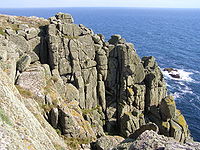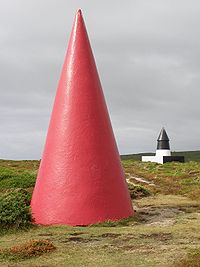
Gwennap Head
Encyclopedia

Headlands and bays
Headlands and bays are two related features of the coastal environment.- Geology and geography :Headlands and bays are often found on the same coastline. A bay is surrounded by land on three sides, whereas a headland is surrounded by water on three sides. Headlands are characterized by high,...
on the south coast of the Penwith
Penwith
Penwith was a local government district in Cornwall, England, United Kingdom, whose council was based in Penzance. The district covered all of the Penwith peninsula, the toe-like promontory of land at the western end of Cornwall and which included an area of land to the east that fell outside the...
peninsula, Cornwall
Cornwall
Cornwall is a unitary authority and ceremonial county of England, within the United Kingdom. It is bordered to the north and west by the Celtic Sea, to the south by the English Channel, and to the east by the county of Devon, over the River Tamar. Cornwall has a population of , and covers an area of...
, United Kingdom
United Kingdom
The United Kingdom of Great Britain and Northern IrelandIn the United Kingdom and Dependencies, other languages have been officially recognised as legitimate autochthonous languages under the European Charter for Regional or Minority Languages...
. The South West Coast Path
South West Coast Path
The South West Coast Path is Britain's longest waymarked long-distance footpath and a National Trail. It stretches for , running from Minehead in Somerset, along the coasts of Devon and Cornwall, to Poole Harbour in Dorset. Since it rises and falls with every river mouth, it is also one of the more...
closely follows the entire coastline around the headland. Its intricate and varied granite cliffs include the famous Chair Ladder crag, making it a popular destination for recreational climbers of all abilities. Another name for the headland is Tol-Pedn-Penwith which comes from the Cornish
Cornish language
Cornish is a Brythonic Celtic language and a recognised minority language of the United Kingdom. Along with Welsh and Breton, it is directly descended from the ancient British language spoken throughout much of Britain before the English language came to dominate...
for 'the holed headland of Penwith', referring to its many chasms and caves.

National Coastwatch Institution
The National Coastwatch Institution is a voluntary organisation and registered charity providing a visual watch along the UK's coasts, and is not to be confused with HM Coastguard.-History:...
station on the headland in the former coastguard building.

Runnel Stone
The Runnel Stone is a hazardous rock pinnacle situated about a mile south of Gwennap Head, Cornwall, United Kingdom that used to show above the surface at low water until a steamship struck it in 1923.-Marks:...
. These are day markers
Daymark
A daymark or a day marker is a structure such as a tower constructed on land as an aid to navigation by sailors. While similar in concept to a lighthouse, a daymark does not have a light and so is usually only visible during daylight hours...
warning vessels of the hazard of the Runnel Stone
Runnel Stone
The Runnel Stone is a hazardous rock pinnacle situated about a mile south of Gwennap Head, Cornwall, United Kingdom that used to show above the surface at low water until a steamship struck it in 1923.-Marks:...
. The cone to the seaward side is painted red and the inland one is black and white. When at sea the black and white one should always be kept in sight in order to avoid the submerged rocks nearer the shore. If the black and white cone is completely obscured by the red cone then the vessel would be directly on top of the Runnel Stone. The black and white landmark was erected by the Corporation of Trinity House
Trinity House
The Corporation of Trinity House of Deptford Strond is the official General Lighthouse Authority for England, Wales and other British territorial waters...
in 1821 - an event recorded on a plaque on the back of the marker.
Rare and endangered bird species
Gwennap Head is renowned for its relative abundance of passing marine bird species such as Manx and Sooty's Shearwaters, skuas, petrels and whimbrelWhimbrel
The Whimbrel Numenius phaeopus, is a wader in the large family Scolopacidae. It is one of the mostwidespread of the curlews, breeding across much of subarctic North America, Europe and Asia as far south as Scotland....
s. In addition, a colony of breeding gannets are close by. Therefore the headland is favoured by birdwatchers and many travel the length and breadth of Britain to track rare seabirds. Annually, the Seawatch SW survey aims to record the numbers of such species from a designated location close to the cliff edge on Gwennap Head.
External links
- Photo gallery of climbers on Chair Ladder from UKClimbing.com.
- NCI Gwennap Head - Coastwatch at Gwennap Head
- http://www.seawatch-sw.org/index.html Seawatch SW bird survey

